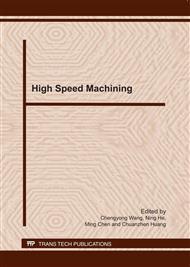[1]
Information on http: /aluminium. matter. org. uk/content/html/ENG/default. asp?catid=147&pageid=2144416564 accessed 4 July (2010).
Google Scholar
[2]
P. L. B. Oxley, Predicting the influence of ultra high cutting speeds on machining, Proc Int Conf Prec Eng, Taipei, Taiwan ROC, November 1997, pp.19-24.
Google Scholar
[3]
P. Mathew and P.L.B. Oxley, Predicting the effects of very high cutting speeds on cutting forces, etc, CIRP Annals, Vol 31/1, 1982, pp.49-52.
DOI: 10.1016/s0007-8506(07)63267-3
Google Scholar
[4]
J. A. Arsecularatne,B. Kristyanto, and P. Mathew, An Investigation of the High Speed Machining Process using a Variable Flow Stress Machining Theory, Int J Mach Sci and Tech (Marcel Dekker), Vol 8, No 2, 2004, pp.211-233.
DOI: 10.1081/mst-200028736
Google Scholar
[5]
P. L. B. Oxley, Mechanics of Machining: An Analytical Approach to Assessing Machinability, (Ellis Horwood, Chichester, UK, 1989).
Google Scholar
[6]
J. A. Arsecularatne and P. Mathew, The Oxley Modelling Approach – its Applications and Future Directions, Int. J. Mach Sci & Tech, Vol 4, No 3, 2000, pp.363-397.
Google Scholar
[7]
M. E. Merchant, , Basic Mechanics of Metal Cutting Process, J. Appl. Mech., Vol. 11, 1944, pp. A168-A175.
DOI: 10.1115/1.4009380
Google Scholar
[8]
C. W. MacGregor, J. C. Fisher, A Velocity-Modified Temperature for the Plastic Flow of Metals, J. Appl. Mech., Vol. 13, 1946, pp. A11-A16.
DOI: 10.1115/1.4009510
Google Scholar
[9]
B. Krisyanto, P. Mathew and J. A. Arsecularatne, Determination of Forces in High Speed Machining (HSM) from Machining Tests and a Variable Flow Stress Machining Theory in Metal Cutting and High Speed Machining edited by D Dudzinski, A Molinari and H. Schulz Kluwer Academic/Plenum Publishers, NY (2002).
DOI: 10.4028/www.scientific.net/amr.188.128
Google Scholar
[10]
Oyane, M., Takashima, F., Osakada, K., Tanaka, H., The Behaviour of Some Steels Under Dynamic Compression, Proc 10th Japan Congress on Testing Materials, 1967, 75-76.
Google Scholar
[11]
J. A. Arsecularatne, B. Kristyanto and P. Mathew, An Investigation of the High Speed Machining Process using a Variable Flow Stress Machining Theory, Int J Mach Sci and Tech (Marcel Dekker), Vol 8, No 2, 2004, pp.211-233.
DOI: 10.1081/mst-200028736
Google Scholar


